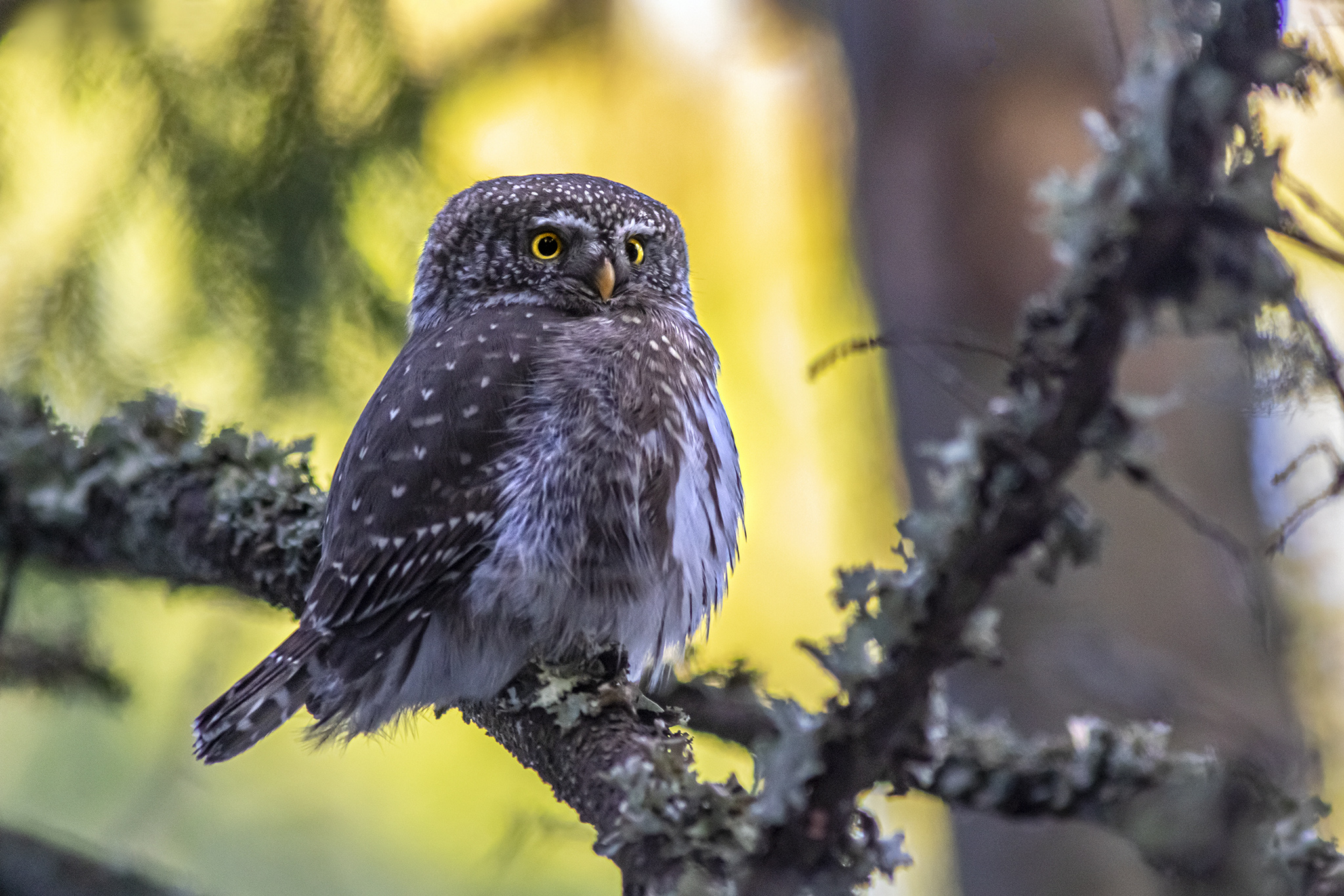Deep Overview: Eurasian Pygmy Owl (Glaucidium passerinum)
The Eurasian Pygmy Owl (Glaucidium passerinum) is the smallest owl species in Europe, measuring just 15–19 cm in length. Despite its small size, this owl is a fierce and skilled hunter, often preying on birds as large as itself. It is primarily found in boreal forests across Europe and northern Asia, where it is active during the daytime—a rare trait among owls. Known for its high-pitched calls and aggressive hunting behavior, the Eurasian Pygmy Owl plays a vital role in maintaining balance within forest ecosystems.
Taxonomy & Classification
- Kingdom: Animalia
- Phylum: Chordata
- Class: Aves
- Order: Strigiformes (Owls)
- Family: Strigidae (True Owls)
- Genus: Glaucidium
- Species: Glaucidium passerinum
- Common Name: Eurasian Pygmy Owl
Physical Description
- Size:
- Length: 15–19 cm (5.9–7.5 inches)
- Wingspan: 32–39 cm (12.6–15.4 inches)
- Weight: 50–80 g (1.8–2.8 oz)
- Coloration & Markings:
- Dark brown plumage with white speckles on the back and wings
- Whitish underparts with fine brown streaks
- Large, round head with yellow eyes
- Lacks ear tufts, giving it a smooth-headed appearance
- False “eye spots” on the back of the head, which may confuse predators
- Sexual Dimorphism:
- Females are slightly larger than males but otherwise similar in appearance
Distribution & Habitat
- Geographic Range:
- Found in northern and central Europe, across Scandinavia, the Alps, and parts of Russia
- Extends into northern Asia, including Siberia and Mongolia
- Preferred Habitat:
- Prefers dense coniferous forests, especially spruce and pine forests
- Also found in mixed woodlands with clearings and old trees for nesting
- Usually inhabits higher elevations in mountainous areas
Behavior & Adaptations
- Activity Pattern:
- Unlike most owls, it is diurnal and crepuscular, meaning it hunts during the day and twilight
- Most active during dawn and dusk
- Territoriality:
- Highly territorial, with males defending their space aggressively
- Males use high-pitched whistles to mark their territory
- Flight Pattern:
- Quick and direct flight, resembling that of a songbird
- Silent flight due to soft-edged feathers
- Adaptations:
- Excellent vision in low light, allowing it to hunt effectively at dawn and dusk
- Sharp talons and strong beak for taking down prey
Diet & Hunting Techniques
- Primary Diet:
- Small mammals (voles, mice, shrews)
- Small birds (tits, warblers, finches, and even thrushes)
- Occasionally insects, amphibians, and reptiles
- Hunting Strategy:
- Perches on high vantage points and watches for movement below
- Can store prey in tree cavities for later consumption (a behavior known as “caching”)
- Capable of taking prey as large as itself
- Unique Feeding Adaptation:
- Often decapitates birds before storing them, making it easier to consume later
Reproduction & Life Cycle
- Breeding Season:
- March to June
- Mating Behavior:
- Males attract females by calling and offering food
- Pairs are typically monogamous for the breeding season
- Nesting:
- Nests in old woodpecker holes or natural tree cavities
- Does not build its own nest
- Eggs & Incubation:
- Clutch size: 3–7 eggs
- Incubation period: 28–30 days (female incubates while male provides food)
- Chick Development:
- Chicks hatch blind and helpless
- Fledge in about 30 days, though parents continue to feed them for weeks after
- Lifespan:
- Typically 5–7 years in the wild, but can live up to 10 years
Predators & Threats
- Natural Predators:
- Larger owls (Tawny owls, Ural owls)
- Hawks and falcons
- Martens and other tree-climbing mammals
- Human-Related Threats:
- Deforestation leading to habitat loss
- Climate change affecting prey availability
- Illegal pet trade (though not common)
- Conservation Status:
- Least Concern (IUCN Red List) but vulnerable to habitat destruction
Ecological Importance
- Natural Pest Control:
- Helps control rodent populations, preventing agricultural damage
- Prey for Larger Predators:
- Plays an important role in the food chain
- Indicator Species:
- The presence of Glaucidium passerinum is a sign of healthy, old-growth forests
Relationship with Humans
- Difficult to Spot:
- Despite being widespread, its small size and secretive nature make it hard to observe
- Popular Among Birdwatchers:
- Considered a prized sighting due to its rare appearances and diurnal habits
- Not Considered a Threat:
- Unlike larger owls, it does not prey on farm animals or pose risks to humans
Similar Species & Identification
- Tengmalm’s Owl (Aegolius funereus)
- Larger, with yellow-ringed eyes and a distinct facial disc
- Little Owl (Athene noctua)
- More grayish-brown, often found in open farmland
- Northern Pygmy Owl (Glaucidium gnoma)
- Found in North America, slightly larger with darker markings
Fun Facts
- It is the smallest owl in Europe, but its fearlessness makes it a top predator
- Mimics bird alarm calls to confuse prey before striking
- Can store up to 10 prey items in a single tree cavity for future meals
- Has “false eyes” on the back of its head, which help deter attacks from behind
- Sometimes hunts even larger birds, such as robins and woodpeckers
Conclusion
The Eurasian Pygmy Owl is a tiny yet powerful predator, thriving in old coniferous forests across Europe and Asia. Unlike most owls, it is active during the day and hunts songbirds and small mammals with remarkable efficiency. Although not endangered, habitat destruction threatens its populations, making forest conservation crucial for its future.
Views: 534
Subscribe to the newsletter:
